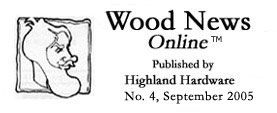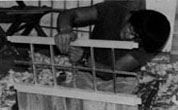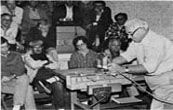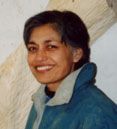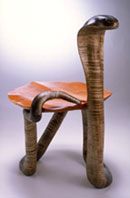|
||||||||
|
|
||||||||
|
|
|
|||
|
The Flowing Forms of Furniture
Artist & Sculptor Sabiha Mujtaba
Sabiha Mujtaba: Hammersmith College of Art and Building in London had a trade directed school. Sculpture students were encouraged to spend allotted term times to learn from the guilding, bricklaying, plastering, welding and woodworking shops. Although I enjoyed all the options, I preferred welding and woodshop. Many years later it was a chance meeting through friends that I began my loose apprenticeship with Timothy Sutherland in Atlanta.
SM: My inspirations for designs are probably a distillation of a collected subconscious - about nature, humanity, culture, experience, etc. - intuitive creativity?
SM:
The snake image was first
used as a convenient form to create a jewelry box - a stylized,
circular form - contained, complete and sensuous.
SM: I use drapery to soften the straight lines necessary in furniture. But with its inclusion I can express its universal use in rituals and ceremonies, as a metaphor for the hidden emotions, or just simply to animate a furniture piece.
SM: Once an idea is developed I usually stay with that, especially if it's a commissioned piece; however, I am selective of grain pattern that enhances the curves or forms in that piece.
SM:
The exciting aspects
of furniture making/woodworking for me are the creative/design process
and the final finish - everything in between is a challenge that
ranges from patting myself on the back for begrudgingly making that
jig for those two perfect joints, to yawning through the seemingly
endless sanding, almost a third of any project time.
SM:
My basement studio with
its 8' ceiling is dry with natural light on two walls. Most of the
major tools are loaned by a friend who changed profession for a
more lucrative livelihood - without Duncan's generosity at a crucial
time, I may not have been a furniture maker. With his Powermatic
table-saw, jointer, drill press, radial arm saw and Delta band-saw
and some of my own hand tools, I began my independence in a field
where women woodworkers were still an anomaly. In the early '80s,
in the USA, Wendy Maruyama and Gail Friedell were the first women
graduating from RIT (Rochester Institute of Technology) furniture
program, and
SM:
The first serious
technical book on carving was William Schnute's
High Relief Wood
Carving
. Today a better book is one I recommend in my classes,
Architectural Carving:
Techniques for Power and Hand Tools
by Mike Burton
(202373), which takes a more thorough look at tools and techniques.
Apart from the tech books, I suggest woodworkers read more on
creativity - anything from David Pye's
The Nature and Aesthetics
of Design
(200595) to today's makers, (regularly
profiled in
Woodwork
magazine) who talk more about their
inspiration and process.
|
|||
|
